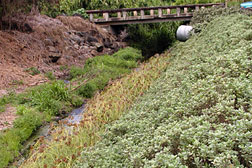|
In The Garden
Rick Barboza
|
Planting now helps prevent erosion later
With the rain in full effect it can be quite a blessing. The rain helps replenish the diminishing aquifers that give us fresh drinking water; it signals to our native stream fish ('o'opu) and shrimp ('opae) that it's time to send the offspring out into the ocean to take the next step in their life cycle; and it makes for a greener Hawaii, feeding hungry plants affected by drought.
 HU KU MOALI OLA
The near slope planted with pohinahina controls erosion while the opposite slope, which has yet to be planted, shows signs of erosion.
|
|
However, all this rain can cause a problem in terms of controlling erosion. Many times, barren, denuded hillsides and slopes can become heavily eroded during prolonged rainfall. Generally, this eroded "muddy" material ends up streaming down the slope, onto the road, and into storm drains and eventually streams that lead to the ocean. From here, the silt is deposited onto coral reefs, blocking their sunlight, choking them to death.
Although erosion is a natural process, we live in a very unnatural environment. The presence of people on these islands has increased the rate of erosion exponentially. From land clearing for development to the introduction of feral ungulates that eat the land clean, we are losing soil faster than nature can replace it -- not to mention the land, ocean and the creatures within it that are most affected.
While many people only think of their immediate environment only when things go wrong, many homeowners don't realize they can be held responsible for the damage caused by erosion of their property, prompting a visit from the State Department of Health's Clean Water Branch. Depending on the severity of damage, you may be subject to a hefty fine.
So what should you do? If you're experiencing this problem now with all the rain we've been having, it's a little too late. A quick, inexpensive fix would be to cover the hillside (assuming that it's not too steep) with coarse mulch. It's the rain's initial impact that loosens surface soil, causing it to erode. What the mulch does is absorb the rain's impact, soak up the water and ease it into the ground, like a slow-drip irrigation system.
In addition to helping to control erosion, mulch adds nutrients to the soil and keeps weeds from growing. This method works as a temporary Band-Aid until the rain dies down and you can repair erosion by planting the area.
A less frugal approach would be to cover the affected area with erosion control matting made from woven coconut husks, held in place with wooden stakes. This has the same effect as the mulch but can be applied to steeper slopes because the stakes keep it in place. You can even cut the mat and plant into it.
The best thing to do to control an eroding slope is to plant it. Over the years I've worked on many projects aimed at controlling erosion, primarily on denuded stream banks that crumble directly into the water.
My nursery has come up with a mix of plants that generally works well together. The first plant we use is Pohinahina (Vitex rotundifolia), a quick grower that sends out long runners that root wherever a node (the point of a plant where new leaves or roots emerge) touches the ground. The roots hold soil in place. Within a few months after planting every two feet, growth should be quite dense.
Nanea (Vigna mariana) is another good groundcover because of its fast growth and thick coverage of nice foliage and yellow pea flowers. Native grasses like kawelu (Eragrostis variabilis) and pili (Heteropogon contortus) have good soil-stabilizing roots, make nice groundcovers and work great in sunny areas. They work well as solid coverings, mixed together or when paired shrub/tree mix.
Within the groundcovers mentioned above, other shrubs can be added to break up the monotony: 'A'ali'i (Dodonea viscosa), which has a deep taproot and nice spread, and is valued for lei making; Ma'o (Gossypium tomentosum), Hawaiian cotton noted for its beauty and ability to spread; Naio (Myoporum sandwicense), a false sandalwood that grows fast and has dense, dark green foliage and Kulu'i (Nototrichium sandwicense), with nice foliage and a fibrous root system.
In general, the plants listed are great for areas that only receive periodic heavy rains because they are all drought tolerant, retaining their fullness even in the driest conditions.
In heavily shaded areas, plants like ferns: palapalai (Microlepia strigosa), kupukupu (Nephrolepis exalta, N. cordifolia) and hapu'u (Cibotium spp.) work well, although the hapu'u grows slowly.
Rick Barboza co-owns Hui Ku Maoli Ola, a native Hawaiian plant nursery, with Matt Schirman. Contact him at 259-6580 or e-mail
rickbarboza@aol.com.

